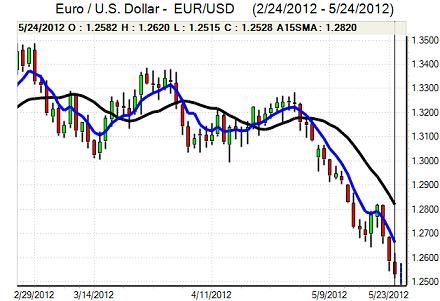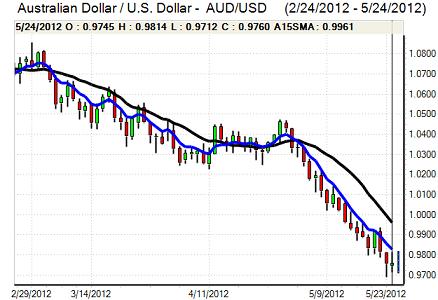EUR/USD
The Euro was subjected to further heavy selling pressure in Europe on Thursday with weaker than expected economic data triggering renewed downward pressure. The German manufacturing PMI index fell to a three-year low of 45.0 from 46.6 previously which contributed to an overall Euro-zone flash reading of 45.0 from 45.9 in April. Although the German services sector held firm above the 50 benchmark, the overall Euro reading fell to 46.5 from 46.9
The German IFO index weakened to a six-month low of 106.9 from 109.9 as it was unable to sustain the run of better than expected releases. The economic data reinforced pessimism surrounding the Euro-zone economy and also increased pressure for further ECB policy action. There were rumours that the bank would look to cut interest rates at the June council meeting.
As risk appetite also remained weak, the Euro dipped to lows near 1.2520 before correcting strongly back to the 1.26 region with buying triggered in part by gains against the Swiss franc. There was also renewed speculation over a fresh LTRO operation which helped underpin equity markets. ECB President Draghi called for the EU to take a courageous leap of political faith.
The latest US jobless claims edged marginally lower to 370,000 from 372,000 previously. There was a 0.2% gain in durable goods orders for Aril while core orders recorded a second successive decline with a 0.6% drop. This was significantly weaker than expected and will reinforce doubts over investment trends. The debut US PMI manufacturing index from market recorded a decline to 53.9 from 56.0 previously. Fed Governor Dudley was slightly more optimistic surrounding the US economy, but repeated that further action would be taken if required.
The Euro was unable to break back above the 1.2620 area against the dollar and weakened back to 2-year lows in the 1.2520 region with significant selling even though risk conditions were slightly more stable and it remained weak on Friday.

Source: VantagePoint Intermarket Analysis Software
Call now and you will be provided with FREE recent forecasts
that are up to 86% accurate* 800-732-5407
If you would rather have the recent forecasts sent to you, please go here
Yen
After stalling in the 79.50 area, the dollar dipped to lows around 79.35 against the yen following the weaker than expected US data releases. There was little follow-through yen buying and the US currency was able to regain some ground later in New York.
There was some easing of defensive demand for the US dollar during the New York session which allowed US Treasury yields to rise and also underpin the US currency.
National core consumer prices rose 0.2% in the year to April, but Tokyo deflation intensified in May with a reading of -0.8% which will maintain pressure on the Bank of Japan to take additional policy action to combat deflation. The dollar was able to move towards the 79.80 region in Asia on Friday.
Sterling
The first-quarter UK GDP data was revised to a figure of -0.3% from an original estimate of -0.2% which further undermined confidence in the economic outlook as construction activity was revised even weaker.
A stronger US currency following the weak Euro-zone data did more damage to Sterling than the domestic data and it retreated to twice test lows just below 1.5650 against the US currency after being blocked above 1.57.
The weaker than expected data increased speculation that the Bank of England would move towards additional quantitative easing within the next two months. Safe-haven considerations were still important as UK benchmark gilt yields dipped to fresh record lows before correcting slightly higher. There will be the potential for further defensive flows into Sterling, but here will also be fears over the serious negative impact on the UK economy if the Euro-zone deteriorates further.
Swiss franc
After weeks of extremely narrow trading ranges and reports of heavy National Bank intervention to defend the 1.20 minimum level, the Euro moved sharply higher on Thursday. After initial speculation over intervention, the move was attributed to rumours that a deposit tax would be levied to discourage speculative inflows into Swiss assets.
The Euro pushed to a high above 1.2050, but there was no follow-through buying and it retreated back to the 1.2020 area later in the US session. Although the dollar was blocked in the 0.9590 area against the franc, it held the bulk of gains.
There will still be expectations of defensive inflows into the Swiss currency given persistent fears surrounding the Euro-zone outlook.

Source: VantagePoint Intermarket Analysis Software
Call now and you will be provided with FREE recent forecasts
that are up to 86% accurate* 800-732-5407
If you would rather have the recent forecasts sent to you, please go here
Australian dollar
After finding support on dips towards 0.9720, the Australian dollar rallied during the early New York session with a peak close to 0.98. Volatility remained high and there was a further test of the 0.9720 area as the Euro was subjected to renewed selling pressure.
There were further concerns surrounding the Asian economy with Chinese officials reporting that bank lending was weakening and there was a very cautious tone surrounding the outlook. In this context, the Australian currency was unable to gain any significant traction.



